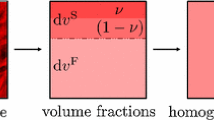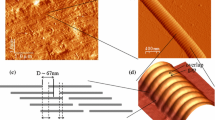Abstract
Cartilage matrix mechanical function is largely determined by interactions between the collagen fibrillar network and the proteoglycan gel. Although the molecular physics of these matrix constituents have been characterized and modern imaging methods are capable of localized measurement of molecular densities and orientation distributions, theoretical tools for using this information for prediction of cartilage mechanical behavior are lacking. We introduce a means to model collagen network contributions to cartilage mechanics based upon accessible microstructural information (fibril density and orientation distributions) and which self-consistently follows changes in microstructural geometry with matrix deformations. The interplay between the molecular physics of the collagen network and the proteoglycan gel is scaled up to determine matrix material properties, with features such as collagen fibril pre-stress in free-swelling cartilage emerging naturally and without introduction of ad hoc parameters. Methods are developed for theoretical treatment of the collagen network as a continuum-like distribution of fibrils, such that mechanical analysis of the network may be simplified by consideration of the spherical harmonic components of functions of the fibril orientation, strain, and stress distributions. Expressions for the collagen network contributions to matrix stress and stiffness tensors are derived, illustrating that only spherical harmonic components of orders 0 and 2 contribute to the stress, while orders 0, 2, and 4 contribute to the stiffness. Depth- and compression-dependent equilibrium mechanical properties of cartilage matrix are modeled, and advantages of the approach are illustrated by exploration of orientation and strain distributions of collagen fibrils in compressed cartilage. Results highlight collagen-proteoglycan interactions, especially for very small physiological strains where experimental data are relatively sparse. These methods for determining matrix mechanical properties from measurable quantities at the microscale (composition, structure, and molecular physics) may be useful for investigating cartilage structure-function relationships relevant to load-bearing, injury, and repair.
Similar content being viewed by others
References
Alhadlaq HA, Xia Y (2004) The structural adaptations in compressed articular cartilage by microscopic MRI (microMRI) T(2) anisotropy. Osteoarthr Cartil 12(11):887–894
Armstrong CG, Lai WM, Mow VC (1984) An analysis of the unconfined compression of articular cartilage. J Biomech Eng 106:165–173
Barocas VH, Tranquillo RT (1997) An anisotropic biphasic theory of tissue-equivalent mechanics: the interplay among cell traction, fibrillar network deformation, fibril alignment, and cell contact guidance. J Biomech Eng 119(2):137–145
Bashir A, Gray ML, Hartke J, Burstein D (1999) Nondestructive imaging of human cartilage glycosaminoglycan concentration by MRI. Magn Reson Med 41(5):857–865
Benninghoff A (1925) Form und bau der gelenkknorpel in ihren beziehungen zur funktion II. Der aufbau des gelenkknorpels in seinen beziehungen zur funktion. Z Zellforsch Mikrosk Anat 2:783–862
Billiar KL, Sacks MS (2000) Biaxial mechanical properties of the native and glutaraldehyde-treated aortic valve cusp: Part II—A structural constitutive model. J Biomech Eng 122(4):327–335
Brenner H, Edwards DA (1993) Macrotransport Processes. Butterworth, Stoneham
Buschmann MD, Grodzinsky AJ (1995) A molecular model of proteoglycan-associated electrostatic forces in cartilage mechanics. J Biomech Eng 117:179–192
Camacho NP, West P, Torzilli PA, Mendelsohn R (2001) FTIR microscopic imaging of collagen and proteoglycan in bovine cartilage. Biopolymers 62(1):1–8
Chen AC, Bae WC, Schinagl RM, Sah RL (2001) Depth- and strain-dependent mechanical and electromechanical properties of full- thickness bovine articular cartilage in confined compression. J Biomech 34(1):1–12
Driessen NJ, Peters GW, Huyghe JM, Bouten CV, Baaijens FP (2003) Remodeling of continuously distributed collagen fibres in soft connective tissues. J Biomech 36(8):1151–1158
Eisenberg SR, Grodzinsky AJ (1988) Electrokinetic micromodel of extracellular matrix and other polyelectrolyte networks. Physicochemical Hydrodynamics 10:517–539
Farquhar T, Dawson PR, Torzilli PA (1990) A microstructural model for the anisotropic drained stiffness of articular cartilage. J Biomech Eng 112:414–425
Frank EH, Grodzinsky AJ (1987) Cartilage electromechanics I—electrokinetic transduction and the effects of electrolyte pH and ionic strength. J Biomech 20(6):615–627
Grodzinsky AJ (1983) Electromechanical and physicochemical properties of connective tissues. CRC Criti Rev Biomed Eng 9(2):133–199
Happel J (1959) Viscous flow relative to arrays of cylinders. AIChE Journal 5:174–177
Hunziker EB, Michel M, Studer D (1997) Ultrastructure of adult human articular cartilage matrix after cryotechnical processing. Microsc Res Tech 37(4):271–284
Jeffery AK, Blunn GW, Archer CW, Bentley G (1991) Three- dimensional collagen architecture in bovine articular cartilage. J Bone Joint Surg Br 73(5):795–801
Jin M, Grodzinky AJ (2001) Effect of electrostatic interactions between glycosaminoglycans on the shear stiffness of cartilage: a molecular model and experiments. Macromolecules 34:8330–8339
Jurvelin JS, Buschmann MD, Hunziker EB (1997) Optical and mechanical determination of poisson’s ratio of adult bovine humeral articular cartilage. J Biomech 30(3):235–241
Kääb MJ, Ito K, Clark JM, Notzli HP (1998) Deformation of articular cartilage collagen structure under static and cyclic loading. J Orthop Res 16(6):743–751
Khalsa P, Eisenberg SR (1997) Compressive behavior of articular cartilage is not completely explained by proteoglycan osmotic pressure. J Biomech 30(6):589–594
Kim YJ, Bonassar LJ, Grodzinsky AJ (1995) The role of cartilage streaming potential, fluid flow, and pressure in the stimulation of chondrocyte biosynthesis during dynamic compression. J Biomech 28(9):1055–1066
Kuwabara S (1959) The forces experienced by randomly distributed parallel circular cylinders or spheres in a viscous flow at small Reynolds numbers. J Physical Soc Japan 14:527–532
Li LP, Buschmann MD, Shirazi-Adl A (2000) A fibril reinforced nonhomogeneous poroelastic model for articular cartilage: inhomogeneous response in unconfined compression. J Biomech 33(12):1533–1541
Luo Z, Sun Y, Fujii T, An K (2004) Single molecule mechanical properties of type II collagen and hyaluronan measured by optical tweezers. Biorheology 41(3–4):247–254
Malvern L (1969) Introduction to the mechanics of a continuous medium. Prentice-Hall, Englewood Cliffs
Maroudas A (1976) Balance between swelling pressure and collagen tension in normal and degenerate cartilage. Nature 260:808–809
Maroudas A, Bannon C (1981) Measurement of swelling pressure in cartilage and comparison with the osmotic pressure of constituent proteoglycans. Biorheology 18(3–6):619–632
Maroudas A, Muir H, Wingham J (1969) The correlation of fixed negative charge with glycosaminoglycan content of human articular cartilage. Biochim Biophys Acta 177:492–500
Maroudas A, Wachtel E, Grushko G, Katz EP, Weinberg P (1991) The effect of osmotic and mechanical pressures on water partitioning in articular cartilage. Biochim Biophys Acta 1073:285–294
Mizrahi J, Maroudas A, Lanir Y, Ziv I, Webber TJ (1986) The instantaneous deformation of cartilage: effects of collagen fiber orientation and osmotic stress. Biorheology 23:311–330
Mollenhauer J, Aurich M, Muehleman C, Khelashvilli G, Irving TC (2003) X-ray diffraction of the molecular substructure of human articular cartilage. Connect Tissue Res 44(5):201–207
Morel V, Quinn TM (2004a) Short-term changes in cell and matrix damage following mechanical injury of articular cartilage explants and modeling of microphysical mediators. Biorheology 41(3–4):509–519
Morel V, Quinn TM (2004b) Cartilage injury by ramp compression near the gel diffusion rate. J Orthop Res 22(1):145–151
Mow VC, Holmes MH, Lai WM (1984) Fluid transport and mechanical properties of articular cartilage: a review. J Biomech 17(5):377–394
Park S, Krishnan R, Nicoll SB, Ateshian GA (2003) Cartilage interstitial fluid load support in unconfined compression. J Biomech 36(12):1785–1796
Pins G, Huang E, Christiansen D, Silver F (1997) Effects of static axial strain on the tensile properties and failure mechanisms of collagen fibers. J Appl Polym Sci 63(11):1429–1440
Quinn TM, Dierickx P, Grodzinsky AJ (2001a) Glycosaminoglycan network geometry may contribute to anisotropic hydraulic permeability in cartilage under compression. J Biomech 34(11):1483–1490
Quinn TM, Morel V, Meister JJ (2001b) Static compression of articular cartilage can reduce solute diffusivity and partitioning: implications for the chondrocyte biological response. J Biomech 34(11):1463–1469
Reynaud B, Quinn TM (2006) Anisotropic hydraulic permeability in compressed articular cartilage. J Biomechan 39(1):131–137
Seog J, Dean D, Plaas A, Wong-Palms S, Grodzinsky A, Ortiz C (2002) Direct measurement of glycosaminoglycan intermolecular interactions via high-resolution force spectroscopy. Macromolecules 35:5601–5615
Soulhat J, Buschmann MD, Shirazi-Adl A (1999) A fibril-network-reinforced biphasic model of cartilage in unconfined compression. J Biomech Eng 121(3):340–347
Torzilli PA, Arduino JM, Gregory JD, Bansal M (1997) Effect of proteoglycan removal on solute mobility in articular cartilage. J Biomechan 30(9):895–902
Williams JM, Uebelhart D, Thonar EJ, Kocsis K, Modis L (1996) Alteration and recovery of the spatial orientation of the collagen network of articular cartilage in adolescent rabbits following intra-articular chymopapain injection. Connect Tissue Res 34(2):105–117
Wilson W, van Donkelaar CC, van Rietbergen B, Ito K, Huiskes R (2004) Stresses in the local collagen network of articular cartilage: a poroviscoelastic fibril-reinforced finite element study. J Biomech 37(3):357–366
Wilson W, van Donkelaar CC, van Rietbergen B, Huiskes R (2005) A fibril-reinforced poroviscoelastic swelling model for articular cartilage. J Biomech 38(6):1195–1204
Xia Y, Elder K (2001) Quantification of the graphical details of collagen fibrils in transmission electron micrographs. J Microsc 204 (Pt 1):3–16
Xia Y, Moody JB, Burton-Wurster N, Lust G (2001) Quantitative in situ correlation between microscopic MRI and polarized light microscopy studies of articular cartilage. Osteoarthr Cartil 9(5):393–406
Zamparo O, Comper WD (1989) Hydraulic conductivity of chondroitin sulfate proteoglycan solutions. Arch Biochem Biophys 274(1): 259–269
Author information
Authors and Affiliations
Corresponding author
Rights and permissions
About this article
Cite this article
Quinn, T.M., Morel, V. Microstructural Modeling of Collagen Network Mechanics and Interactions with the Proteoglycan Gel in Articular Cartilage. Biomech Model Mechanobiol 6, 73–82 (2007). https://doi.org/10.1007/s10237-006-0036-z
Received:
Accepted:
Published:
Issue Date:
DOI: https://doi.org/10.1007/s10237-006-0036-z




